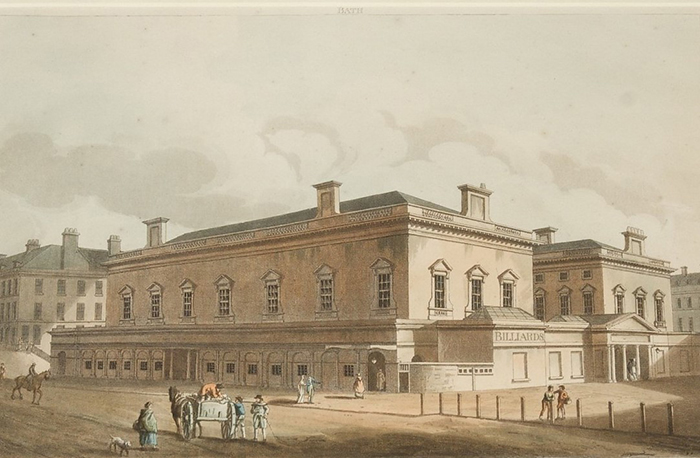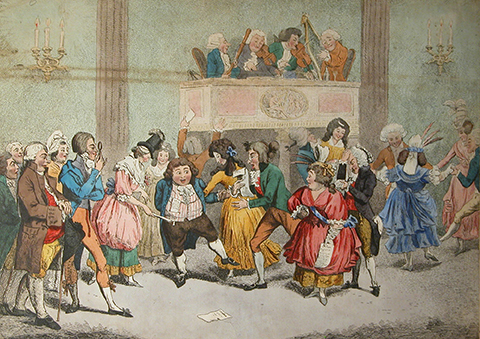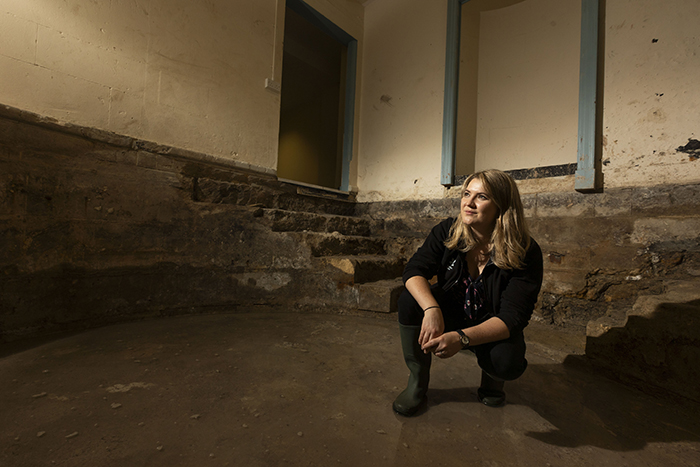Rare, if not unique, 18-century cold bath is uncovered in Bath during recent excavations

Assembly Rooms, Bath, by John Claude Nattes (c.1765 – 1839), National Trust Images/Simon Harris
Archaeological excavations in the basement below the 18th-century Bath Assembly Rooms have revealed the remains of what was once a popular form of taking the waters for health purposes – a cold bath.
However, specialists believe that this could be the only cold bath of its kind located in a historic assembly room, which in the 18th and 19th centuries was a popular place of entertainment, conversation, dancing and gambling in many fashionable towns.
Bath and many other spa towns were known for their hot mineral water and became popular spots for bathing and taking the waters, but in the 18th century, medical practitioners also recommended cold bathing for men and women as beneficial for various physical and mental ailments, including gout. They advised regular, if not daily, bathing by plunging into cold water for a short period of time and then warming up quickly afterwards.
There was a surge in plunge pools and cold baths in private houses and estates along with public facilities in Bath and other towns, however the location of the one at the Assembly Rooms suggests it would have been more exclusive, and for those wanting a more private cold bath experience.
The Bath Assembly Rooms, now cared for by the National Trust, were built between 1769-1771 by John Wood the Younger, who would have been heavily influenced by medical theories of the time. The cold bath was one of many rooms in the building. The New Bath Guide of 1778 noted “…a commodious cold-bath, with convenient dressing-rooms,” and there were rooms for billiards, coffee and gambling along with spaces for balls and concerts, making it a one-stop-shop for all leisure, health and entertainment needs.

A drawing of the weekly Cotillion Ball held at the Bath Assembly Rooms during the Georgian era. © National Trust/Christopher Warleigh-Lack
Beneath one end of the ballroom is a suite of three rooms: the cold bath in the center, with dressing rooms to either side. The excavation involved removing a later floor that had been installed over the cold bath and the removal of tons of rubble, revealing historic steps down into the bath and its finely joined stone walls, as well as a niche which would have held a statue or sculpture.
It is likely that someone wanting to access the bath would have arrived, perhaps by sedan chair, and then entered from the street using a staircase in the northeastern corner of the Assembly Rooms, rather than via the main entrance to the building.
During World War II, the Assembly Rooms were bombed, and the cold bath suffered damage. In the years after the war, the bath was filled in with rubble and a floor laid over the top, although research suggests a floor may have been laid over as early as the beginning of the 20th century and the space used for storage.
Tatjana LeBoff, National Trust Project Curator explained: “There are many elements of this discovery that are still a mystery. The cold bath at the Assembly Rooms is highly unusual. It is a rare, if not unique, surviving example, and possibly it was the only one ever built in an assembly room.”
She continued: “Whilst our records tell us about a variety of people who were employed at the Bath Assembly Rooms in the 1770s, none of the records mention anyone being employed to attend the Cold Bath. Nor are there records of bath sheets being hired or bought or any laundry service for them, so perhaps the bather would have brought their own towels and servant to help with bathing and dressing.
“It is unlikely men and women of status would have used the Cold Bath together so there could have been different days or times when they were available to each. We are
still researching records, letters, diaries and other documents to see what more we can find out that will help us piece it all together.”

Alana Wright, National Trust Experience & Visitor Programming Manager, in the newly uncovered 18th-century cold bath. National Trust Images/James Beck
The excavation of the Bath Assembly Rooms Cold Bath was overseen by Wessex Archaeology. Bruce Eaton, Archaeologist at Wessex Archaeology, said: “Although historical records indicated that there was a cold bath buried beneath the Bath Assembly Rooms, we had no idea what preservation of the bath would be like. The building suffered damage at the hands of the Luftwaffe and the rooms were remodeled in the late 20th century but, after carefully excavating tons of concrete and rubble, we saw the original structure emerge in its entirety.
“It’s tremendous to be able to piece together this rare archaeological evidence of an 18th-century cold bath with social historical accounts from the time – a fantastic result for the National Trust and visitors to the Bath Assembly Rooms.”
The excavation is part of a major project by the National Trust to create an experience that will transport visitors back to the social scene of Bath in the late 18th- and early 19th-centuries, whilst remaining open as much as possible during this transition.
Join Royal Oak in Supporting the Important Work at the Bath Assembly Rooms
Royal Oak is dedicated to raising $1 Million to help the National Trust in their work at the Assembly Rooms. Learn more about how funds from Royal Oak members will be used to restore the grandeur and elegance of one of England’s most important, historic gathering places.



